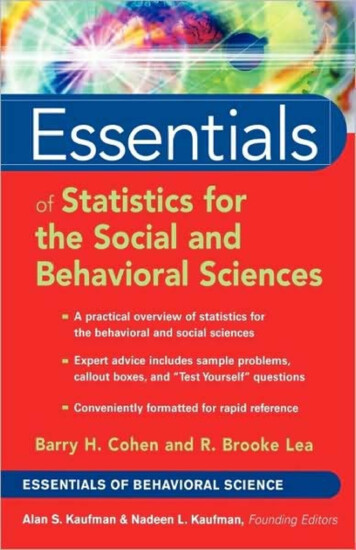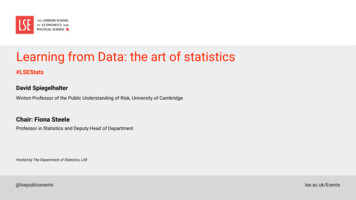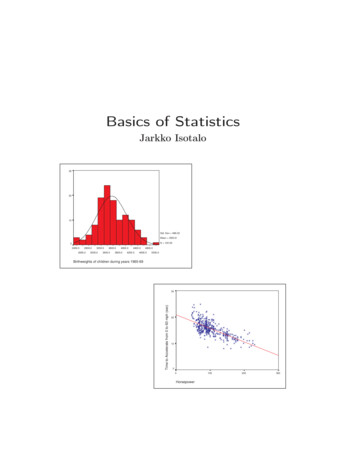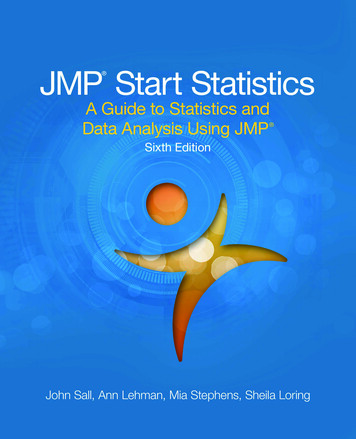
Transcription
Essentialsof Statistics for the Socialand Behavioral SciencesBarry H. CohenR. Brooke LeaJohn Wiley & Sons, Inc.
Essentials of Statistics for the Socialand Behavioral Sciences
Essentials of Behavioral Science SeriesFounding Editors, Alan S. Kaufman and Nadeen L. KaufmanEssentials of Statistics for the Social and Behavioral Sciencesby Barry H. Cohen and R. Brooke LeaEssentials of Psychological Testingby Susana UrbinaEssentials of Research Design and Methodologyby Geoffrey R. Marczyk and David DeMatteo
Essentialsof Statistics for the Socialand Behavioral SciencesBarry H. CohenR. Brooke LeaJohn Wiley & Sons, Inc.
Copyright 2004 by John Wiley & Sons, Inc. All rights reserved.Published by John Wiley & Sons, Inc., Hoboken, New Jersey.Published simultaneously in Canada.No part of this publication may be reproduced, stored in a retrieval system, or transmitted in any formor by any means, electronic, mechanical, photocopying, recording, scanning, or otherwise, except aspermitted under Sections 107 or 108 of the 1976 United States Copyright Act, without either the priorwritten permission of the Publisher, or authorization through payment of the appropriate per-copyfee to the Copyright Clearance Center, Inc., 222 Rosewood Drive, Danvers, MA 01923, (978) 7508400, fax (978) 750-4470, or on the web at www.copyright.com. Requests to the Publisher forpermission should be addressed to the Permissions Department, John Wiley & Sons, Inc., 111 RiverStreet, Hoboken, NJ 07030, (201) 748-6011, fax (201) 748-6008, e-mail: permcoordinator@wiley.com.Limit of Liability/Disclaimer of Warranty: While the publisher and author have used their best effortsin preparing this book, they make no representations or warranties with respect to the accuracy orcompleteness of the contents of this book and specifically disclaim any implied warranties ofmerchantability or fitness for a particular purpose. No warranty may be created or extended by salesrepresentatives or written sales materials. The advice and strategies contained herein may not besuitable for your situation. You should consult with a professional where appropriate. Neither thepublisher nor author shall be liable for any loss of profit or any other commercial damages, includingbut not limited to special, incidental, consequential, or other damages.This publication is designed to provide accurate and authoritative information in regard to the subjectmatter covered. It is sold with the understanding that the publisher is not engaged in renderingprofessional services. If legal, accounting, medical, psychological or any other expert assistance isrequired, the services of a competent professional person should be sought.Designations used by companies to distinguish their products are often claimed as trademarks. In allinstances where John Wiley & Sons, Inc. is aware of a claim, the product names appear in initial capitalor all capital letters. Readers, however, should contact the appropriate companies for more completeinformation regarding trademarks and registration.For general information on our other products and services please contact our Customer CareDepartment within the U.S. at (800) 762-2974, outside the United States at (317) 572-3993 or fax(317) 572-4002.Wiley also publishes its books in a variety of electronic formats. Some content that appears in printmay not be available in electronic books. For more information about Wiley products, visit ourwebsite at www.wiley.com.Library of Congress Cataloging-in-Publication Data:Cohen, Barry H., 1949–Essentials of statistics for the social and behavioral science / Barry H. Cohen, R. Brooke Lea.p. cm. — (Essentials of behavioral sciences series)Includes bibliographical references and index.ISBN 0-471-22031-0 (pbk. : alk. paper)1. Social sciences—Statistical methods. I. Lea, R. Brooke. II. Title. III. Series.HA29.C65 2003519.5—dc212003049669Printed in the United States of America.10987654321
To my dear Aunts: Harriet Anthony and Diana FranzblauBHCTo Emily and Jackson, the two parameters that keep me normalRBLWe would like to sincerely thank Irving B. Weiner, Ph.D., ABPP forhis assistance as a consulting editor on this project.Dr. Weiner completed his doctoral studies at the University of Michigan in 1959 and went on to write and edit over 20 books, as well ascountless chapters and journal articles. A Diplomate of the AmericanBoard of Professional Psychology in both Clinical and Forensic Psychology, he currently serves as Clinical Professor of Psychiatry andBehavioral Medicine at the University of South Florida. Dr. Weinerserves as Chairman of the Wiley Behavioral Sciences Advisory Boardand is Editor-in-Chief of the 12-volume Handbook of Psychology,which published in December 2002.
CONTENTSSeries PrefaceixOneDescriptive Statistics1TwoIntroduction to Null Hypothesis Testing28ThreeThe Two-Group t II Test48FourCorrelation and Regression71One-Way ANOVA and Multiple Comparisons97FivePower Analysis122Factorial ANOVA145EightRepeated-Measures ANOVA172NineNonparametric Statistics199Appendix AStatistical Tables226Appendix BAnswers to Putting it into Practice Exercises243References275Annotated Bibliography278SixSevenvii
viii CONTENTSIndex281Acknowledgments291About the Authors291
SERIES PREFACEIn the Essentials of Behavioral Science series, our goal is to provide readers withbooks that will deliver key practical information in an efficient, accessible style.The series features books on a variety of topics, such as statistics, psychological testing, and research design and methodology, to name just a few. For the experienced professional, books in the series offer a concise yet thorough review ofa specific area of expertise, including numerous tips for best practices. Studentscan turn to series books for a clear and concise overview of the important topicsin which they must become proficient to practice skillfully, efficiently, and ethicallyin their chosen fields.Wherever feasible, visual cues highlighting key points are utilized alongside systematic, step-by-step guidelines. Chapters are focused and succinct. Topics are organized for an easy understanding of the essential material related to a particulartopic. Theory and research are continually woven into the fabric of each book, butalways to enhance the practical application of the material, rather than to sidetrackor overwhelm readers. With this series, we aim to challenge and assist readers inthe behavioral sciences to aspire to the highest level of competency by armingthem with the tools they need for knowledgeable, informed practice.Essentials of Statistics for the Social and Behavioral Sciences concentrates on drawingconnections among seemingly disparate statistical procedures and providing intuitive explanations for how the basic formulas work. The authors weave statisticalconcepts together and thus make the different procedures seem less arbitrary andisolated. The statistical procedures covered here are those considered essential toresearchers in the field. Only univariate statistics are presented; topics in multivariate statistics (including multiple regression) deserve a separate volume of theirown. Further, this book assumes that the reader has a working knowledge of basic statistics or has ready access to an introductory text. Therefore, this book willnot bog down the reader down with computational details. Thus, this book shouldbe ideal as a supplementary text for students struggling to understand the materix
x SERIES PREFACEial in an advanced (or sophisticated) undergraduate statistics course, or an intermediate course at the master’s level. Essentials of Statistics is also ideal for researchersin the social and behavioral sciences who have forgotten some of their statisticaltraining and need to brush up on statistics in order to evaluate data, converseknowledgeably with a statistical consultant, or prepare for licensing exams.Chapter 1 covers the most often used methods of descriptive statistics, and thenext four chapters cover the basics of null hypothesis testing and interval estimation for the one-, two-, and multigroup cases, as well as the case of two continuous variables. Chapter 6 is devoted to the increasingly essential topics of poweranalysis and effect size estimation for the cases covered in Chapters 2 through 5.Chapters 7 and 8 deal with the complex forms of analysis of variance common inexperimental social science research. As appropriate, these chapters include material relevant to the larger topic of research design. Finally, Chapter 9 includessome of the most popular methods in nonparametric statistics. Regrettably, manyuseful topics had to be omitted for lack of space, but the references and annotatedbibliography point the reader toward more comprehensive and more advancedtexts to fill any gaps. Indeed, we hope that this book will help the reader understand those more advanced sources. Additional material to help readers of thisbook understand the statistical topics covered in this book, as well as some relatedand more advanced topics, are posted on the web and can be accessed by following links from tml.Alan S. Kaufman, PhD, and Nadeen L. Kaufman, EdD, Founding EditorsYale University School of Medicine
Essentials of Statistics for the Socialand Behavioral Sciences
OneDESCRIPTIVE STATISTICSSocial and behavioral scientists need statistics more than most other scientists, especially the kind of statistics included in this book. For the sake ofcontrast, consider the subject matter of physics. The nice thing about protons and electrons, for instance, is that all protons have the same mass; electronsare a lot lighter, but they also are all identical to each other in mass. This is not toimply that physics is easier than any of the social or behavioral sciences, but thefact that animals and especially humans vary so much from each other alongevery conceivable dimension creates a particular need to summarize all this variability in order to make sense of it.The purpose of descriptive statistics is to use just a few numbers to capture themeaning of a much larger collection of observations on many different cases. Thesecases could be people, animals, or even cities or colleges; or the same cases on manydifferent occasions; or some combination of the two. Often, computing descriptive statistics is just your first step in a process that uses more advanced statisticalmethods to make estimates about cases that you will never have the opportunity tomeasure directly. This chapter will cover only descriptive statistics. The remainingchapters will be devoted to more advanced methods called inferential statistics.SAMPLES AND POPULATIONSSometimes you have all of the observations in which you are interested, but thisis rare. For instance, a school psychologist may have scores on some standardizedtest for every sixth grader in Springfield County and her only concern is studyingand comparing students within the County. These test scores would be thoughtof as her population. More often, you have just a subset of the observations inwhich you are interested. For instance, a market researcher randomly selects andcalls 100 people in Springfield County and asks all of them about their use of theInternet. The 100 observations obtained (Springfield residents are very cooperative) do not include all of the individuals in which the researcher is interested. The1
2 ESSENTIALS OF STATISTICS100 observations would be thoughtof as a sample of a larger population.If as a researcher you are interested in the Internet habits of peopleWhen Will I Use the Statisticsin This Chapter?in Springfield County, your population consists of all the people in thatYou have measured the same variablecounty. If you are really interested inmany times, perhaps on many different people, or many different rats, orthe Internet habits of people in themany different cities (e.g., the totalUnited States, then that is your popubudget for each city), and so on, andlation. In the latter case your samplenow you want to summarize all ofmay not be a good representation ofthose numbers in a compact and descriptive way. If you want to extrapothe population. But for the purposeslate from those numbers to cases youof descriptive statistics, populationshave not measured yet, you will needand samples are dealt with in similarthe tools that we will begin to describe in Chapter 2.ways. The distinction between sampleand population will become importantin the next chapter, when we introduce the topic of inferential statistics. For now, we will treat any collection of numbers that you have as a population.The most obvious descriptive statistic is one that summarizes all of the observations with a single number—one that is the most typical or that best locates themiddle of all the numbers. Such a statistic is called a measure of central tendency. Thebest-known measure of central tendency is the arithmetic mean: the statistic youget if you add up all the scores in your sample (or population) and divide by thenumber of different scores you added. When people use the term mean you canbe quite sure that they are referring to the arithmetic mean. There are other statistics that are called means; these include the geometric and the harmonic mean(the latter will be discussed in Chapter 5). However, whenever we use the termmean by itself we will be referring to the arithmetic mean. Although the mean iscalculated the same way for a sample as a population, it is symbolized as 苶X (pronounced “X bar”) or M when it describes a sample, and (the lowercase Greekletter mu; pronounced “myoo”) when it describes a population. In general, numbers that summarize the scores in a sample are called statistics (e.g., 苶X is a statistic), whereas numbers that summarize an entire population are called parameters(e.g., is a parameter).DON ’ T FORGETSCALES OF MEASUREMENTWhen we calculate the mean for a set of numbers we are assuming that these numbers represent a precise scale of measurement. For instance, the average of 61
DESCRIPTIVE STATISTICS3inches and 63 inches is 62 inches, and we know that 62 is exactly in the middle of61 and 63 because an inch is always the same size (the inch that’s between 61 and62 is precisely the same size as the inch between 62 and 63). In this case we can saythat our measurement scale has the interval property. This property is necessary tojustify and give meaning to calculating means and many other statistics on themeasurements that we have. However, in the social sciences we often use numbers to measure a variable in a way that is not as precise as measuring in inches.For instance, a researcher may ask a student to express his or her agreement withsome political statement (e.g., I think U.S. senators should be limited to two 6-yearterms) on a scale that consists of the following choices: 1 strongly disagree; 2 somewhat disagree; 3 neutral; 4 somewhat agree; 5 strongly agree. [Thiskind of scale is called a Likert scale, after its inventor, Rensis Likert (1932).]Ordinal ScalesYou might say that a person who strongly agrees and one who is neutral, when averaged together, are equivalent to someone who somewhat agrees, because themean of 1 and 3 is 2. But this assumes that “somewhat agree” is just as close to“strongly agree” as it is to neutral—that is, that the intervals on the scale are allequal. All we can really be sure of in this case is the order of the responses—thatas the responses progress from 1 to 5 there is more agreement with the statement.A scale like the one described is therefore classified as an ordinal scale. The morepoints such a scale has (e.g., a 1 to 10 rating scale for attractiveness), the morelikely social scientists are to treat the scale as though it were not just an ordinalscale, but an interval scale, and therefore calculate statistics such as the mean onthe numbers that are reported by participants in the study. In fact, it is even common to treat the numbers from a 5-point Likert scale in that way, even though statisticians argue against it. This is one of many areas in which you will see that common practice among social scientists does not agree with the recommendationsof many statisticians (and measurement experts) as reported in textbooks andjournal articles.Another way that an ordinal scale arises is through ranking. A researcher observing 12 children in a playground might order them in terms of aggressiveness,so that the most aggressive child receives a rank of 1 and the least aggressive getsa 12. One cannot say that the children ranked 1 and 2 differ by the same amountas the children ranked 11 and 12; all you know is that the child ranked 5, for instance, has been judged more aggressive than the one ranked 6. Sometimes measurements that come from an interval scale (e.g., time in seconds to solve apuzzle) are converted to ranks, because of extreme scores and other problems(e.g., most participants solve the puzzle in about 10 seconds, but a few take sev-
4 ESSENTIALS OF STATISTICSeral minutes). There is a whole set of procedures for dealing with ranked data,some of which are described in Chapter 9. Some statisticians would argue thatthese rank-order statistics should be applied to Likert-scale data, but this is rarelydone for reasons that will be clearer after reading that chapter.Nominal ScalesSome of the distinctions that social scientists need to make are just qualitative—they do not have a quantitative aspect, so the categories that are used to distinguishpeople have no order, let alone equal intervals. For instance, psychiatrists diagnosepeople with symptoms of mental illness and assign them to a category. The collection of all these categories can be thought of as a categorical or nominal scale (thelatter name indicates that the categories have names rather than numbers) formental illness. Even when the categories are given numbers (e.g., the Diagnostic andStatistical Manual of Mental Disorders used by psychologists and psychiatrists has anumber for each diagnosis), these numbers are not meant to be used mathematically (e.g., it doesn’t make sense to add the numbers together) and do not evenimply any ordering of the categories (e.g., according to the Diagnostic and StatisticalManual of Mental Disorders, fourth edition [DSM-IV ], Obsessive-Compulsive Disorder is 300.3, and Depressive Disorder is 311; but the diagnostic category forsomeone suffering from Obsessive-Compulsive Disorder and Depressive Disorder is not 611.3, nor is it 305.65, the sum and mean of the categories, respectively).Although you cannot calculate statistics such as the mean when dealing withcategorical data, you can compare frequencies and percentages in a useful way.For instance, the percentages of patients that fall into each DSM-IV diagnosis canbe compared from one country to another to see if symptoms are interpreted differently in different cultures, or perhaps to see if people in some countries aremore susceptible to some forms of mental illness than the people of other countries. Statistical methods for dealing with data from both categorical and ordinalscales will be described in Chapter 9.Ratio ScalesThe three scales of measurement described so far are the nominal (categories thathave no quantitative order), the ordinal (the values of the scale have an order, butthe intervals may not be equal), and the interval scale (a change of one unit on thescale represents the same amount of change anywhere along the scale). One scalewe have not yet mentioned is the ratio scale. This is an interval scale that has a truezero point (i.e., zero on the scale represents a total absence of the variable being
DESCRIPTIVE STATISTICS5Rapid Reference 1.1Measurement ScalesNominal: Observations are assigned to categories that differ qualitatively but haveno quantitative order (e.g., depressed, phobic, obsessive, etc.).Ordinal: The values have an order that can be represented by numbers, but thenumbers cannot be used mathematically, because the intervals may not be equal(e.g., assigning ranks according to the ability of gymnasts on a team).Interval: One unit on this scale is the same size anywhere along the scale, so valuescan be treated mathematically (e.g., averaged), but zero on the scale does not indicate a total absence of the variable being measured (e.g., IQ scores).Ratio: This scale has the interval property plus the zero point is not arbitrary; itrepresents a true absence of the variable being measured. For instance, weight inpounds has this property, so that if object A is measured as twice as many poundsas object B, then object A has twice as much weight. (You cannot say that someone with an IQ of 120 is twice as smart as someone with an IQ of 60.)measured). For instance, neither the Celsius nor Fahrenheit scales for measuringtemperature qualify as ratio scales, because both have arbitrary zero points. TheKelvin temperature scale is a ratio scale because on that scale zero is absolutezero, the point at which all molecular motion, and therefore all heat, ceases. Thestatistical methods described in this book do not distinguish between the intervaland ratio scales, so it is common to drop the distinction and refer to interval/ratio data. A summary of the different measurement scales is given in Rapid Reference 1.1.DISPLAYING YOUR DATAWhen describing data there are many options for interval/ratio data, such as themean, but relatively few options for nominal or ordinal data. However, regardlessof the scale you are dealing with, the most basic way to look at your data is interms of frequencies.Bar ChartsIf you have nominal data, a simple bar chart is a good place to start. Along a horizontal axis you write out the different categories in any order that is convenient.The height of the bar above each category should be proportional to the numberof your cases that fall into that category. If 20 of the patients you studied were
6 ESSENTIALS OF STATISTICSphobic and 10 were depressed, the vertical bar rising above “phobic” would betwice as high as the bar above “depressed.” Of course, the chart can be rotated tomake the bars horizontal, or a pie chart or some other display can be used instead,but the bar chart is probably the most common form of display for nominal datain the social sciences.Because the ordering of the categories in a bar chart of nominal data is arbitrary, it doesn’t quite make sense to talk of the central tendency of the data. However, if you want to talk about the most typical value, it makes some sense to identify the category that is the most popular (i.e., the one with the highest bar). Thecategory with the highest frequency of occurrence is called the mode. For instance,among patients at a psychiatric hospital the modal diagnosis is usually schizophrenia (unless this category is broken into subtypes).The bar chart is also a good way to display data from an ordinal scale, but because the values now have an order, we can talk meaningfully about central tendency. You can still determine the mode—the value with the highest bar (i.e., frequency)—but the mode need not be near the middle of your bar chart (althoughit usually will be). However, with an ordinal scale you can add up frequencies andpercentages in a way that doesn’t make sense with a nominal scale. First, let uslook at the convenience of dealing with percentages.Percentile Ranks and the MedianSuppose 44 people in your sample “strongly agree” with a particular statement;this is more impressive in a sample of 142 participants than in a sample of 245participants (note: in keeping with recent custom in the field of psychology, wewill usually use the term participant to avoid the connotations of the older term subject). The easiest way to see that is to note that in the first case the 44 participantsare 31% of the total sample; in the second case, they are only 18%. The percentages make sense without knowing the sample size. Percentages are useful with anominal scale (e.g., 45% of the patients were schizophrenic), but with an ordinalscale there is the added advantage that the percentages can be summed. For example, suppose that 100 people respond to a single question on a Likert scale withthe following percentages: 5% strongly disagree; 9% somewhat disagree; 36% areneutral; 40% agree; and 10% strongly agree. We can then say that 14% (5 9) ofthe people are on the disagree side, or that 14% are below neutral (it’s arbitrary,but we are assigning higher values in the agree direction).We can assign a percentile rank ( PR) to a value on the scale such that the PRequals the percentage of the sample (or population) that is at or below that value.The PR is 5 for strongly disagree, 14 for somewhat disagree, 50 for neutral, 90 for
DESCRIPTIVE STATISTICS7agree, and 100 for strongly agree (it is always 100, of course, for the highest valuerepresented in your set of scores). A particularly useful value in any set of scoresis called the median. The median is defined as the middle score, such that half thescores are higher, and half are lower. In other words, the median is the valuewhose PR is 50. In this example the median is “neutral.” The median is a usefulmeasure of central tendency that can be determined with an ordinal, but not anominal, scale. According to this definition, the median in the preceding examplewould be somewhere between “neutral” and “somewhat agree.” If “neutral” is 3and “somewhat” agree is 4 on the scale, then some researchers would say that themedian is 3.5. But unless you are dealing with an interval scale you cannot use thenumbers of your scale so precisely. If all your scores are different, it is easy to seewhich score is the middle score. If there are only a few different scores (e.g., 1 to5) but many responses, there will be many scores that are tied, making it less clearwhich score is in the middle.HistogramsA slight modification of the bar chart is traditionally used when dealing with interval/ratio data. On a bar chart for nominal or ordinal data there should be somespace between any two adjacent bars, but for interval/ratio data it is usually appropriate for each bar to touch the bars on either side of it. When the bars touch,the chart is called a histogram. To understand when it makes sense for the bars totouch, you need to know a little about continuous and discrete scales, and thereforesomething about discrete and continuous variables. A variable is discrete when itcan only take certain values, with none between. Appropriately, it is measured ona discrete scale (whole numbers—no fractions allowed). For example, family sizeis a discrete variable because a family can consist of three or four or five members, but it cannot consist of 3.76 members.Height is a continuous variable because for any two people (no matter howclose in height) it is theoretically possible to find someone between them inheight. So height should be measured on a continuous scale (e.g., number ofinches to as many decimal places as necessary). Of course, no scale is perfectlycontinuous (infinitely precise), but measuring height in tiny fractions of inchescan be considered continuous for our purposes. Note that some continuous variables cannot at present be measured on a continuous scale. A variable likecharisma may vary continuously, but it can only be measured with a rather crude,discrete scale (e.g., virtually no charisma, a little charisma, moderate charisma,etc.). Data from a continuous scale are particularly appropriate for a histogram.Consider what a histogram might look like for the heights of 100 randomly se-
8 ESSENTIALS OF STATISTICSlected men (for simplicity, we will look at one gender at a time). If the men rangefrom 62 to 76 inches, the simplest scheme would be to have a total of 15 bars, thefirst ranging from 61.5 to 62.5 inches, the second from 62.5 to 63.5 inches, andso on until the 15th bar, which goes from 75.5 to 76.5 inches. Looking at Figure1.1, notice how the bars are higher near the middle, as is the case for many variables (the mode in this case is 69 inches). Now suppose that these men range inweight from 131 to 218 pounds. One bar per pound would require 88 bars (218– 131 1), and many of the bars (especially near either end) would be empty. Thesolution is to group together values into class intervals. For the weight example,10-pound intervals starting with 130–139 and ending with 210–219 for a total ofnine intervals would be reasonable. A total of eighteen 5-pound intervals (130–134 to 215–219) would give more detail and would also be reasonable. The common guidelines are to use between 10 and 20 intervals, and when possible to startor end the intervals with zeroes or fives (e.g., 160–164 or 161–165).Note that if you look at what are called the apparent limits of two adjacent classintervals, they don’t appear to touch—for example, 130–134 and 135–139. However, measurements are being rounded off to the nearest unit, so the real limits ofthe intervals just mentioned are 129.5–134.5 and 134.5–139.5, which obviouslydo touch. We don’t worry about anyone who is exactly 134.5 pounds; we %8%6%4%2%Figure 1.1 A histogram of the heights (in inches) of 100 randomly selectedmen
DESCRIPTIVE STATISTICSassume that if we measure preciselyenough, that person will fall into oneinterval or the other.9DON ’ T FORGETIf you are dealing with nominal (i.e.,categorical) or ordinal data, a barchart is appropriate (the bars do nottouch). If you are dealing with intervalor ratio data, a histogram is appropriate; the bars extend to the lower andupper real limits of the interval represented (even if it is a single unit), andtherefore adjacent bars do touch.PercentilesPercentages can be added, just aswith the ordinal scale, to create percentile ranks. For instance, looking atF
the behavioral sciences to aspire to the highest level of competency by arming them with the tools they need for knowledgeable, informed practice. Essentials of Statistics for the Social and Behavioral Sciencesconcentrates on drawing connections among seemi










